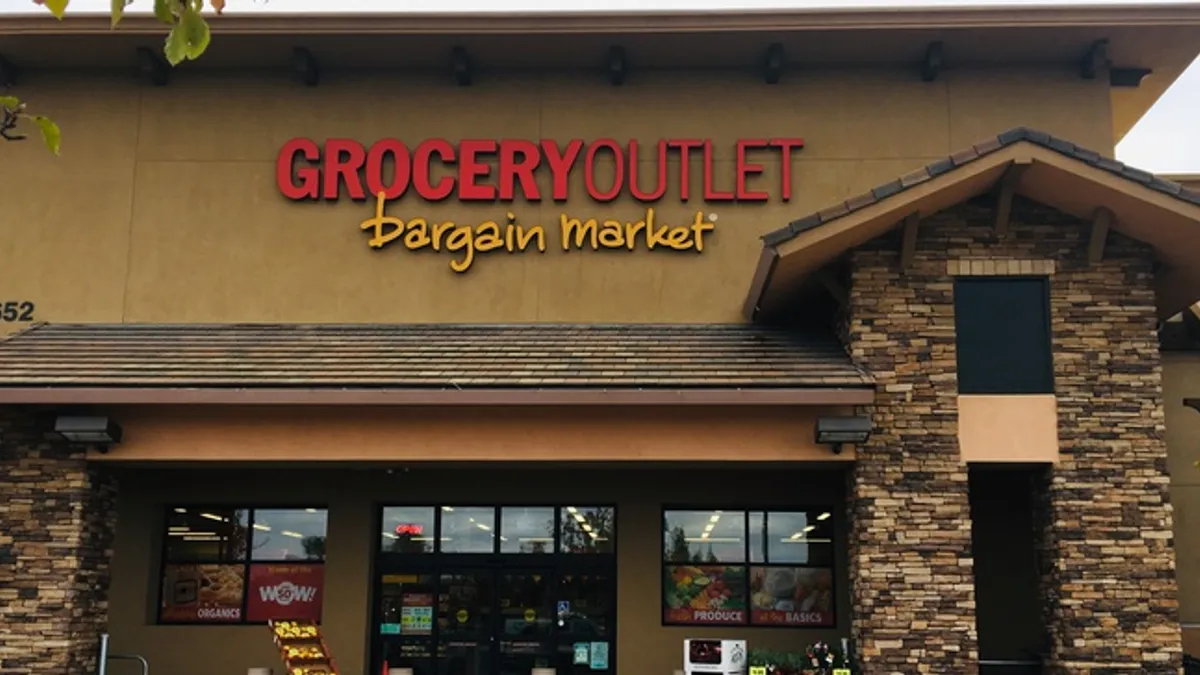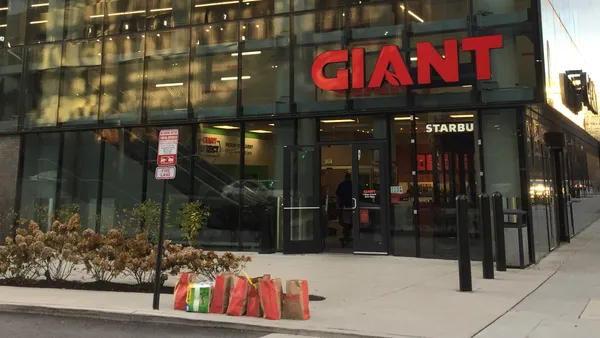Dive Brief:
- Grocery Outlet reported on Tuesday strong first-quarter results with comparable store sales up 5.2% year-over-year and net sales up 10.5%, to $831.4 million, kicking off a fiscal year executives expect will be bright as the discounter capitalizes on supply chain disruptions and price-sensitive shoppers.
- CEO Eric Lindberg said the company plans to roll out e-commerce partnerships with DoorDash and Uber Eats, building on the e-commerce momentum the company started with its recent tie-up with Instacart, which executives said has so far yielded "positive results."
- The company raised its full-year guidance for fiscal year 2022, notably bumping its previously predicted comp store sales increase of 4% to 5% to a range of 5.5% to 6.5%.
Dive Insight:
The “strong top-line growth” Grocery Outlet saw in Q1, which ended April 2, was driven by higher traffic and transaction sizes — both of which are set to remain elevated into Q2, Lindberg told investors.
“We're making continued progress on our new initiatives to expand customer reach and increase share of wallet including e-commerce, SKU expansion [and] development of our mobile app,” Lindberg said during the call.
As inflation disrupts consumer spending habits, executives said Grocery Outlet is well-positioned to meet shopper demands for low prices and unique products with its treasure-hunting experience and supply chain strategies, while also benefiting from a muted impact of inflation on its business model.
Executives expect supply chain disruptions and elevated inflation to continue, but noted those aren’t posing issues to Grocery Outlet in the ways they are to traditional grocery stores.
For example, Grocery Outlet was able to buy “at an extreme value” 20,000 cases of frozen entrees from an unnamed “highly recognized brand” due to issues including rising freight costs, which the chain then sold to customers at a more than 50% discount, Grocery Outlet President RJ Sheedy said.
Sheedy said Grocery Outlet’s basket savings are about 40% relative to other traditional grocery retailers.
Long-hesitant to integrate e-commerce due to its opportunistic buying model, Grocery Outlet has changed its tune recently. The company recently expanded Instacart service to nearly all of its stores following a pilot last summer, and executives said it's on track to begin testing its previously announced loyalty app this summer.
The discounter is now looking to add Uber Eats and DoorDash as e-commerce options for its shoppers.
“Later this quarter, we will launch a pilot with additional partners in the same 68 stores that were part of the Instacart pilot, enabling us to expand our customer reach even further,” Sheedy said on the call.
Executives reiterated Grocery Outlet’s plans to focus on ethnic, local and NOSH products — its natural, high quality and health-based items. “We plan to increase our new SKU count by another 150 as we strive to provide a fuller shop, greater convenience and value,” Sheedy said.
During Q1, Grocery Outlet opened four stores and closed one, ending the quarter with 418 locations across seven states. The chain plans to open 28 net new stores this year, including 10 in the Mid-Atlantic as part of its East Coast expansion, executives said.
For its raised full-year guidance, Grocery Outlet is now expecting net sales to range between $3.39 billion and $3.42 billion. Adjusted EBITDA is predicted to be $213 million to $220 million, up $3 million from the previous range, and diluted adjusted earnings per share are slated to be $0.94 to $0.99, up 2 cents from prior forecasting.
With company executives painting a picture of robust growth ahead, Lindberg positioned labor and Environmental Social Governance (ESG) initiatives at the heart of its operations. The company’s sustainability working group, which was created to identify and assess ESG factors, has developed strategies to support ESG goals and formalize Grocery Outlet’s disclosures, Lindberg said. Grocery Outlet is conducting a materiality assessment and gap analysis this year and expects to publish its first sustainability report in 2023, he added.
On the labor front, Lindberg said the pipeline for its independent operators “remains healthy” as the company invests in training.
“[W]e strengthened our training program for future operators last year to include both in-store learning and a robust online platform. … One of the aspects of the training that gets high marks is a simulation exercise that allows [aspiring operator trainees] to test their strategies in a day-to-day execution in a virtual environment,” he said.












